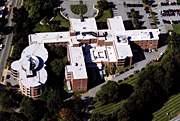
Online filing of emergency leak reports, 24/7, with automatic paging of emergency contacts
Internet-based worldwide sharing of photos and other documentation of jobs-in-progress
The ability to input punch list data in real time using a hand-held PDA or laptop computer
Comprehensive warranty tracking and flagging, as expiration dates come due
On the product side, too, the last 10 years have witnessed the development of innovative high-performance roofing materials capable of extending the anticipated service life of a roof to 30 years and longer. For situations where reroofing is not financially feasible, today's advanced restoration materials can significantly extend the life of mature or moderately damaged roofs until funding becomes available.
Yet, despite the fact that it has probably never been easier to ensure long-term roofing performance, the 2003 Roof Longevity and Replacement Report, funded by the Roofing Industry Alliance for Progress, recently concluded that the average life expectancy of today's commercial low-slope roof is only 17 years.
What's needed is a radical change in the way organizations evaluate outcomes: specifically, a shift from short-term pragmatic thinking, to long-term creative thinking.
The Right Metrics
Is it true that the initial costs of longer lasting roofing solutions are typically higher than the up-front costs of shorter-term solutions? Absolutely. Is it true that the short-term costs associated with aggressive preventive maintenance are higher than those associated with reactive maintenance? Usually, yes.But, as with everything else we buy-from cars and household appliances to the clothes we wear-what you save in the short term, you lose exponentially over time. The recent Commercial Roofing Solutions Pocket Guide on Roof Maintenance reported that reactively maintained roofs more than double the total lifecycle costs of ownership over a 20-year period, when compared with roofs that have been aggressively maintained.
With today's microprocessor technologies, demonstrating that fact using lifecycle cost analysis is easier than you think. Software packages analyzing the potential long-term costs of short-term fixes typically help you identify and measure the costs associated with:
Unanticipated roof repairs
Increasing energy loss as insulation gets wet and loses its effectiveness
Resulting damages to a building's interior
Destroyed furnishings, equipment, and/or inventory
Downtime during repairs
Health problems caused by mold
Liability for accidents resulting from water leakage
Cleaning up water-damaged interiors
Insurance rate increases due to repetitive claims
Eventual premature roof replacement
Often overlooked is the fact that the building codes only allow two roof installations before requiring a costly, complete tear-off. Given the expense associated with roof replacement, a thorough analysis of viable options should always consider the restoration alternative if the roofing insulation remains mostly dry. Restorations are not considered replacements, so regular, periodic restorations can frequently offer significant savings, costing anywhere from 10 to 60 percent less that a total tear-off and replacement, depending on the type and condition of the underlying deck.
The Right Financing
The evidence may be indisputable that the aggressive pursuit of long-term performance pays off. But if that were the only obstacle to our achieving it, we'd all be driving Mercedes and wearing cashmere sweaters. The fact is that purchases demanding even a moderately higher up-front cost are frequently impossible, due to a shortage of fluid capital.For today's building owners, creative financing is becoming increasingly critical to achieving long-term success in the management of their roofing assets. Fortunately, as with management technologies and roofing technologies, the variety of financing methods and programs available has never been greater.
Many state and local governments offer programs that reward owners who are investing in technologies that reduce energy consumption. On the federal level, public facilities can take advantage of General Service Administration pricing schedules to ensure fair and consistent pricing without unduly limiting their purchasing options, depending on their preferred suppliers.
Another alternative that is gaining increased attention from the nonprofit and public sectors is lease financing. When applied to roofing, a lease financing program is a viable alternative to bond financing or cash. Such programs typically allow tax-exempt organizations to pay for a new roof over time, with a dollar buyout.
This option enables schools, public hospitals, universities, municipalities and nonprofit agencies in the United States and Canada to finance a total installed roofing solution with their payments counted as an expense, rather than as capital, against their current budgets. Lease financing can help organizations buy time until expected funding from bond issues or state distributions becomes available, leaving them with valuable capital to invest in other needed projects.
Report Abusive Comment